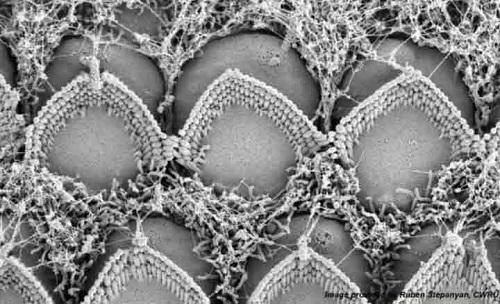CASE WESTERN RESERVE UNIVERSITY - Usher syndrome (USH) is characterized by hearing loss or deafness at birth and progressive vision loss, and is the most common cause of inherited dual sensory deficit. No treatment is currently available to stop or slow the progression of vision or hearing loss in USH3, one of three clinical classifications for USH that are further divided into subtypes and all associated with different genes.
A new study published in Nature Chemical Biology reports the first small molecule targeted therapy for progressive hearing loss in a mouse model of USH3, an USH classified by progressive loss of hearing and vision starting in the first few decades of life along with variable balance disorder. This is caused by destabilizing mutations in the gene encoding the clarin-1 protein (CLRN1). The finding of this targeted therapy in a mouse model holds much promise for the thousands of patients and their families diagnosed with USH3 for whom symptoms can be devastating, and for the physicians who have not yet been able to offer a treatment to preserve hearing or vision in these individuals.

The mechanosensory hair bundle, a highly organized (V-shaped) structure located on the apical surface of the hair cell, is composed of two or more height-ranked rows of stereocilia ("hair"). The destabilizing mutation CLRN1N48K causes loss of hair bundle integrity and hearing the mouse model. CREDIT:
Ruben Stepanyon, Ph.D., Case Western Reserve University School of Medicine
This important research was conducted by a team of scientists at Case Western Reserve University School of Medicine led by Kumar N. Alagramam, PhD, and Yoshikazu Imanishi, PhD, who developed a small molecule to mitigate the effects of the common USH3 mutation Clarin-1-N48K (CLRN1N48K). Members of the team included chemists from BioFocus (U.K.) who optimized the original 'hit' small molecule identified at the School of Medicine, and university researchers who characterized the biochemical properties of the molecules.
The team utilized a novel research strategy involving a cell-based high-throughput screening of small molecules capable of stabilizing the mutant CLRN1N48K, a secondary screening to eliminate general proteasome inhibitors, and finally an iterative process to optimize structure activity relationships, resulting in the identification of the compound BF844. To test the efficacy of BF844, the School of Medicine scientists developed and studied a mouse model that mimicked the progressive hearing loss of USH3, concluding that BF844 effectively attenuated progressive hearing loss and prevented deafness in this model.
"One of the most exciting implications of this research is the potential for real-world translation, as the key to increasing the odds of success for any treatment is the ability to apply it before symptoms appear," said Alagramam, associate professor and director of research for the otolaryngology department at the School of Medicine. "USH3 CLRN1N48K patients are born with the ability to hear and acquire speech and language, with the majority of cases being diagnosed by the age of 10 years. Genetic testing can be used to identify at-risk USH3 CLRN1N48K patients before the onset of hearing loss, and the small molecule treatment with BF844 could, in theory, be started preemptively."
"Notably, these research findings could have broader implications beyond USH3 and hearing loss. Because the human CLRN1N48K mutation causes both hearing and vision loss, this small molecule targeted therapy could, in principle, prevent both sensory deficiencies in USH3 patients." said Imanishi, assistant professor of pharmacology at the School of Medicine. "Moreover, many monogenic disorders are caused by point mutations which destabilize the protein products. Our drug discovery strategy, in theory, will be applicable to identify drugs stabilizing these mutant proteins."
This research is a great example of how a philanthropic effort by a private foundation can make a major difference; The Usher III Initiative, founded by Cindy Elden and her father Richard Elden, generously supported this research. A major advocate within the USH community, Cindy Elden was correctly diagnosed with USH3 in her 30s after being misdiagnosed with USH2 for most of her life. Alongside her father, who has long been dedicated to finding a treatment for his daughter, Elden co-founded the Usher III Initiative as a progressive research consortium that aims to identify the cause of, and develop a cure for, USH3. They are working closely with the School of Medicine with the goal of advancing their findings into an eventual treatment for USH3.
"We were very proud to support the School of Medicine on this groundbreaking research. Their discovery that CLRN1 is the cause of both hearing and vision loss in USH3 patients was an exciting first step, following by their development of the novel small molecule which has been shown to stop mice with USH3 from losing their hearing. Combined, these scientific strides open the door for future USH3 treatment, and give me and the USH3 community tremendous hope," said Elden.
This work was supported by the Usher III Initiative (YI, KNA, and BioFocus group); Hope for Vision (YI); the Prince Family Foundation (YI), Case Western Reserve University (YI), the National Institutes of Health Grants R01-DC010816 (KNA.), R01-EY020826 (YI) and R24 EY021126 (KP); and the Arnold and Mabel Beckman Foundation (KP).
For more information about Case Western Reserve University School of Medicine, please visit: case.edu/medicine.
Source: https://www.eurekalert.org/pub_releases/2016-04/cwru-fsm042616.php

